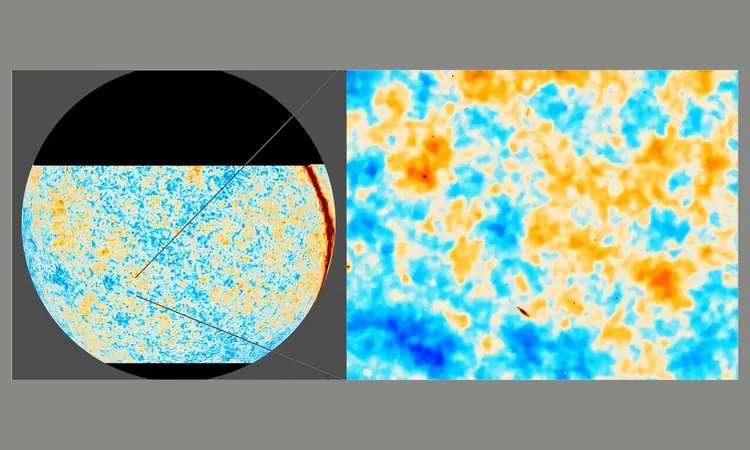
Groundbreaking Images Unveil "Baby Pictures" of the Early Universe!
2025-03-31
Author: Ming
Astronomers have successfully captured the most intricate images of the universe's infancy, showcasing radiant light that has traveled over 13 billion years to reach our planet. This impressive feat was achieved by a dedicated team utilizing a telescope located high in the Chilean Andes, providing unprecedented insights into the cosmos when it was merely 380,000 years old—essentially the universe’s baby pictures.
Suzanne Staggs, the director of the Atacama Cosmology Telescope (ACT) and a professor of physics at Princeton University, remarked, “We are witnessing the initial stages of the formation of the earliest stars and galaxies.” The ACT differentiates itself from other telescopes like Planck by offering high-resolution detailed images of the polarization of light, revealing not just patterns of light and dark but also the dynamic movements within the cosmos.
A Glimpse into the Cosmic Microwave Background (CMB)
The recently released images depict the cosmic microwave background (CMB), the faint afterglow left by the Big Bang, capturing it with five times the resolution of previous observations by Planck. Sigurd Naess, a researcher from the University of Oslo, emphasized, “Our advanced sensitivity makes previously weak polarization signals distinctly observable now.”
These polarization patterns furnish insights into the primordial hydrogen and helium gases' movements, underscoring how gravitational forces were distributed across early cosmic structures. As Staggs explained, “We’re not just mapping where matter was, but also how it was moving—like detecting tides to infer the moon's presence.”
The Early Universe's Evolution
In the immediate aftermath of the Big Bang, the universe was a hot, dense plasma stage, effectively blocking light from traveling freely. Only after enough cooling occurred for atoms to form did photons begin to traverse space, leading to the creation of the CMB—the very first record visible to humanity.
The ACT's extensive sky coverage and precision grant us clarity on the subtle variations in the early universe's matter density. These variances act as precursors to cosmic structures, which, driven by gravity over billions of years, culminated in the formation of the first galaxies and stars.
Jo Dunkley, a professor at Princeton, stated, “By analyzing a time when cosmic conditions were simpler, we can unravel the narrative of the universe's evolution into the vast complexity we observe today.”
New Insights on the Universe's Mass and Composition
Compounding this scientific breakthrough, the research also yielded a revised measurement of the observable universe’s total mass, which now expands almost 50 billion light-years in all directions from us, accounting for an astonishing 1,900 zetta-suns. This encompasses everything from ordinary matter, dark matter, to dark energy.
ACT's detection reinforces cosmological models regarding the universe’s makeup: normal matter (including stars and planets) represents about 100 zetta-suns; dark matter constitutes approximately 500 zetta-suns; dark energy is estimated around 1,300 zetta-suns; and neutrinos contribute a mere 4 zetta-suns. Notably, around 75% of ordinary matter remains as hydrogen, while the rest is primarily helium, with heavier elements forming later in stellar processes.
Refining Cosmological Measurements and Addressing Current Debates
The findings further refine estimations of the universe’s age, which is now declared at 13.8 billion years with a margin of 0.1%. This precision ties into ongoing debates regarding the Hubble constant, which concerns how quickly the universe is currently expanding. Discrepancies between CMB-based and galaxy movement-based measurements have long perplexed astronomers, but ACT's latest results offer a consistent affirmation of the existing cosmological models.
Colin Hill, a researcher from Columbia University, highlighted the significance of ACT's robust data, confirming no evidence to support alternative models predicting faster expansion rates, thus validating our current understanding of cosmology.
Looking Ahead: The Future of Cosmic Studies
ACT’s groundbreaking observations, which required five years of exposure with advanced detectors, completed their mission in 2022. The scientific community is now gearing up for the next-level Simons Observatory at the same Chilean site, promising even deeper insights into the universe's nascent phases.
As scientists continue to unravel the mysterious fabric of the cosmos, discoveries from ACT illuminate the path for future investigations, enhancing our comprehension of the universe’s history, the very forces that shape it, and ultimately our own place within the vast cosmos.
Stay connected for more gripping updates and engaging insights into our universe!



 Brasil (PT)
Brasil (PT)
 Canada (EN)
Canada (EN)
 Chile (ES)
Chile (ES)
 Česko (CS)
Česko (CS)
 대한민국 (KO)
대한민국 (KO)
 España (ES)
España (ES)
 France (FR)
France (FR)
 Hong Kong (EN)
Hong Kong (EN)
 Italia (IT)
Italia (IT)
 日本 (JA)
日本 (JA)
 Magyarország (HU)
Magyarország (HU)
 Norge (NO)
Norge (NO)
 Polska (PL)
Polska (PL)
 Schweiz (DE)
Schweiz (DE)
 Singapore (EN)
Singapore (EN)
 Sverige (SV)
Sverige (SV)
 Suomi (FI)
Suomi (FI)
 Türkiye (TR)
Türkiye (TR)
 الإمارات العربية المتحدة (AR)
الإمارات العربية المتحدة (AR)